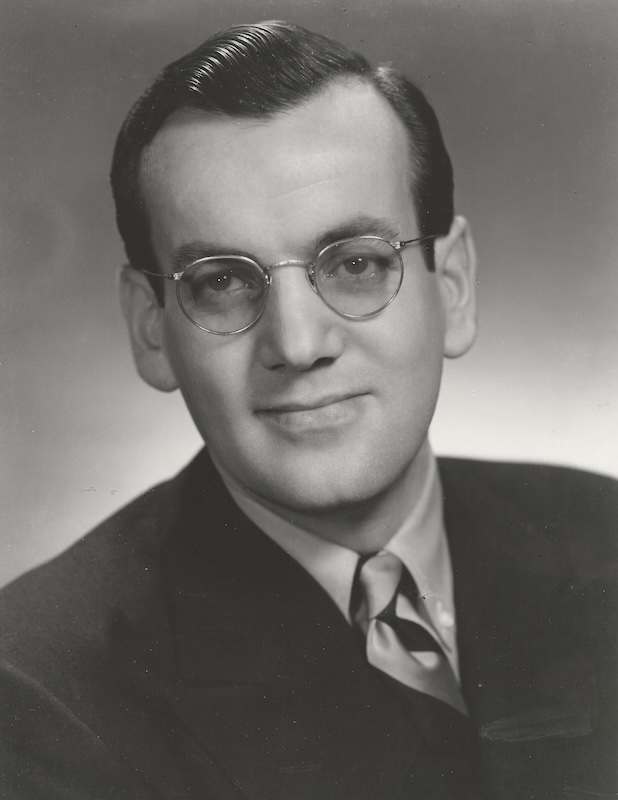
A portrait of Clarinda native and famous Big Band conductor, arranger, composer, trombone player and recording artist Alton Glenn Miller, April 1940. Photos courtesy of Glenn Miller Collections, University of Colorado Boulder
Sept/Oct 2024 (Volume 16, Issue 5)
Part 1 of 2
The ascent of America’s No. 1 bandleader
(Publisher’s note: Our exclusive series about Big Band conductor, recording artist and U.S. Army Air Forces officer Glenn Miller chronicles his meteoric ascent, pinnacle of his popularity, and debunks conspiracies regarding his mysterious death. The second part of our series will continue in our November/December issue.)
By Dennis M. Spragg
On March 1, 1904, Alton Glenn Miller was born at 601 South 16th St. in the southwestern Iowa town of Clarinda. Although his parents would move along and raise him in Nebraska, Missouri and eventually Colorado, the man who became one of the foremost musical celebrities of the 20th century would always consider himself a proud Iowa native … as would idolizing media publicity. Miller fondly remembered Page and Montgomery counties as “cousin country,” and for good reason. Evidence of Miller’s cousins remains to this day in Clarinda and Red Oak.
Miller’s ascent was unlikely, yet it became inevitable. The path from Clarinda to fame led through high school in Fort Morgan, Colo., where he was an all-state football player, to the University of Colorado Boulder, where he dropped out to pursue a full-time musical career. This was the first among many intuitive decisions that resulted in the man who was known as America’s No. 1 bandleader, with more No. 1 records (16) and Top 10 hits (69) than either Elvis Presley or The Beatles. And Miller accomplished this in a short period of time, from 1939 to 1942.
Miller earned the money to buy his first trombone from milking cows and mixing concrete. At Fort Morgan High School, his grades were unimpressive, except for math and Latin. He skipped graduation to play with a band in Laramie, Wyo. Then Miller played regularly in the bands of Boyd Senter and Holly Moyer, from whom he learned much about style and presentation. Miller enrolled at the University of Colorado on Jan. 2, 1923, joined the Sigma Nu fraternity, and continued to work for Moyer. During March 1924, by now employed with the Orville Bond La Croma Club Band in Denver, he received an offer to join the successful Tommy Watkins Westerners. Soon the ambitious young musician dropped out of college to travel the Southwest, Intermountain West and Mexico. Along the way he developed an interest in arranging music as well as polishing his trombone skills. By August 1925, Miller was working in Los Angeles with Max Fisher’s dance band when a major career opportunity appeared.
Talented musician and arranger
Ben Pollack’s Californians were among America’s most popular “Roaring ‘20s” jazz bands. Pollack needed a trombone player, and he hired Miller, who was soon a roommate with another new Pollack musician, Benny Goodman. From 1926 through 1928, Miller appeared on all of Pollack’s popular Victor Records recordings, many of which he arranged. In New York, Miller found himself in demand with recording studios and on Broadway. When Pollack headed west, Miller remained behind. His replacement was the legendary Jack Teagarden.
Meanwhile, Miller decided to settle down. He had maintained a long-distance friendship with Helen Dorothy Burger, the daughter of Boulder County Clerk Fred W. Burger. The couple were married in New York on Oct. 6, 1928. Helen Miller’s impact on her husband’s career was incalculable. She grounded the inerrant jazz musician with discipline, sensitivity and good judgement.
Soon Miller was enjoying a lucrative career despite the Great Depression. In demand on Broadway, he wrote musical parts for George Gershwin and Robert Russell Bennett. Working shows including “Girl Crazy” and “Strike Up The Band” with bandleader Red Nichols, Miller played with many talented jazz musicians. He also performed on recording sessions with famous jazz ensembles. His trombone solo on “Hello, Lola” by the multiracial Mound City Blowers is considered a classic.

A CBS publicity photo of Glenn Miller and His Orchestra at the CBS Vine Street Theater in Hollywood, Calif., in March 1941.
In 1933, Miller joined Smith Ballew’s band. When it broke up in Denver, Miller took the nucleus, including drummer Ray McKinley, to New York and convinced the Dorsey Brothers to build a band around them. During 1934 and into 1935, Miller was the musical director for the Dorsey Brothers Orchestra, writing and arranging many of the band’s hit records.
Early in 1935, popular British bandleader Ray Noble moved to the United States but was prevented from bringing his musicians due to union restrictions. Noble hired Miller to organize his American band, which included future bandleaders Will Bradley (trombone), Charlie Spivak (trumpet) and Claude Thornhill (piano). Resident at the posh Rainbow Room atop Rockefeller Center, Noble’s NBC broadcasts and Victor Records recordings introduced nationwide audiences to Miller’s outstanding musical arrangements. It was with Noble that Miller began to develop the musical style with which he would soon become identified. When Pee Wee Irwin left Noble, Miller salvaged his trumpet parts by having Johnny Mince play the parts on clarinet, which was the genesis of what became the so-called “Glenn Miller sound.”
TO READ THE ENTIRE STORY AND OTHER FASCINATING STORIES ABOUT IOWA HISTORY, subscribe to Iowa History Journal.
